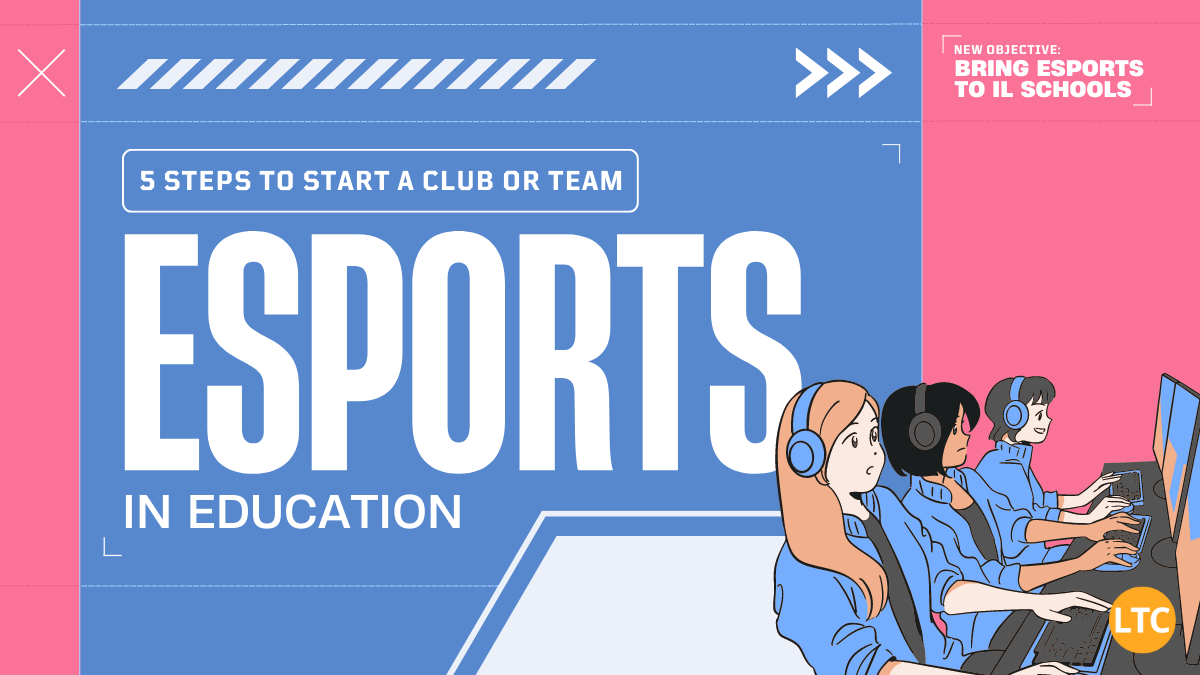Esports in Education: 5 Steps to Start a Club or Team


Esports has seen meteoric growth over the past several years, not just in massive arenas across the world, but also in schools across the US. Here in Illinois, hundreds of high schools already offer esports clubs or teams, with plans for state-level sanctioning of esports competitions already in the works.
All of these schools have recognized esports’ full potential in an educational environment. Through esports, students can reap the benefits of playing on a team while sharpening skills that can give them a leg up on lucrative scholarships (not to mention the tech-connected workforce).
Ready to press “start” on your school’s esports program? Here’s what you need to know to start an esports club or team at your school:


More than Just a Game
At some point in the process of starting an esports club, you may be asked the simple question: “why esports?”
Simply put – esports offer students opportunities to grow academically and athletically, opening them to emergent college and career opportunities.
An esports club is also an opportunity to capture students who aren’t as attracted to traditional team sports and offer them the chance to distinguish themselves based on their unique and valuable skill sets.
Participation in esports helps in the classroom, too. For example, research into K-12 esports programs shows that participants on average have:
- Higher attendance & graduation rates
- Improved communication, collaboration, and social skills
- Improved math and reading comprehension skills
Esports players also gain access to noteworthy postsecondary opportunities. Numerous colleges and universities offer esports scholarships, while those skilled enough can continue on past college in one of the US’ growing esports leagues.
Even if they don’t go pro, esports can be a gateway to numerous emergent fields of study, including coding, information technology, software development, and game design. Participants can also pick up transferable skills to help them break into the modern broadcast entertainment industry.


Step #0 – Get Buy-In from Stakeholders
As early as possible in the process, work toward obtaining buy-in for your esports club from key school or district stakeholders. This ensures that they feel in the loop about this new development and allows them an opportunity to highlight potential roadblocks before they crop up.
Obtaining buy-in also helps you more effectively communicate your needs for funds, space, and resources, some of which administrators and district leaders can help secure.
As you obtain buy-in from district stakeholders, you may be asked how esports constitutes a “sport” that the school should support. Taos Esports’ “Five Pillars” can help reframe “athletics” in this context and provide a basis for justifying your club’s creation.


Step #1 – Establish a Program
First and foremost, your esports club needs a coach. That leader can be anyone – even you!
Don’t worry if you aren’t an esports expert yourself. All you need is some working knowledge of the games you plan to coach. Your students can serve as your content experts, helping you select games and develop strategies once the club is established.
Once you have your coach selected, begin working through your school’s new club or after-school program creation process. This may require you to outline budgetary needs, space needs, and resource needs (see below for more details).
Remember – start small! A club-sized group is a perfect size to establish your esports program while you build interest and secure sustainable funding.


Step #2 – Research Hardware & Create a Budget
With your coach in place, it’s time to start researching the hardware and software your esports club will need.
These don’t need to be top-of-the-line models, but they will likely need to meet higher specifications than your school’s computer lab units can offer.
In particular, you’ll want to keep a few key specifications in mind, such as CPU speed, monitor refresh rates, and internal cooling (among many others).
Also, top-tier internet speeds are an absolute must for esports. Nearly all esports are facilitated through online servers, so your chosen gaming units (either PC or console) will need hardwired ethernet connections that can sustain high volume traffic over extended periods.


Step #3 – Secure Funding & Acquire Equipment
With your research and budget in hand, you’re ready to start purchasing your esports club’s hardware and software.
Much of the best esports equipment can be obtained at a discount through ILTPP’s pre-negotiated contracts.
Keep in mind that your acquisition needs may differ if you choose to focus on PC gaming (which requires each player to have their own monitor, keyboard, etc), console gaming (which requires only a single console with separate controllers), or a mix of both.
When it comes to paying for those necessities (especially high speed internet), E-Rate funding can be a major asset. Other grants are also available to help districts overcome startup costs associated with starting an esports team.


Step #4 – Talk Logistics with your IT Team
Logistics are a big potential stumbling block for your fledgling esports club, so talk to your building’s IT team early and often.
In particular, you should discuss your building’s options for high speed ethernet hookups. Reliable high speed internet greatly reduces latency in online games, which can make a sizable difference during most esports’ split-second gameplay.
At the same time, you should start a conversation about how your club members will communicate and collaborate digitally. Discord is one popular voice chat app used widely in the online gaming community, but your IT team may need to whitelist to make it accessible on school networks.


Step #5 – Secure a Meeting Space
If you haven’t already, determine your space needs and make sure your fledgling esports club has a place to meet. This will likely need to be a specialized space with room for gaming chairs, desks, computers/consoles, and high speed internet hookups.
You may need to work with administrators and your IT team to find such a location or create one from scratch.
When it comes to a meeting space, don’t feel limited to your building alone, either. Reach out to local universities and see if they have a space available that meets your club’s needs. If they have their own club, connect with them as soon as possible. They can be a great source for mentoring, as well as insights on maintaining your new club over time.
The Next Step
Once you have the basics down, you can start working toward recruiting team members and holding your first meeting. Before you can do that though, you’ll need to set a code of conduct, obtain buy-in from parents, and promote your new esports club throughout your school.
Check out this video for more insights on getting your esports group across the starting line:
Helping You Press “Start” on your Esports Program
Whether you’re on level one or looking to power up your esports team, the Learning Technology Center is here to be your player two. We offer low-cost trainings that can help your district turn its esports dreams into a reality.
Reach out to your local RETC to learn more about our esports supports or to schedule a customized esports training in your district.
Further Reading & Resources



Eric develops and leads professional learning programs, trainings, and resources related to curricular integration, digital access, and technology infrastructure in the Chicagoland region.



Holly assists educators throughout the state in addressing digital responsibility, fostering positive online behaviors, and enhancing social-emotional skills among students.



Sam leads and supports the execution and growth of LTC services through the development and creation of innovative, impactful, and timely digital content.

